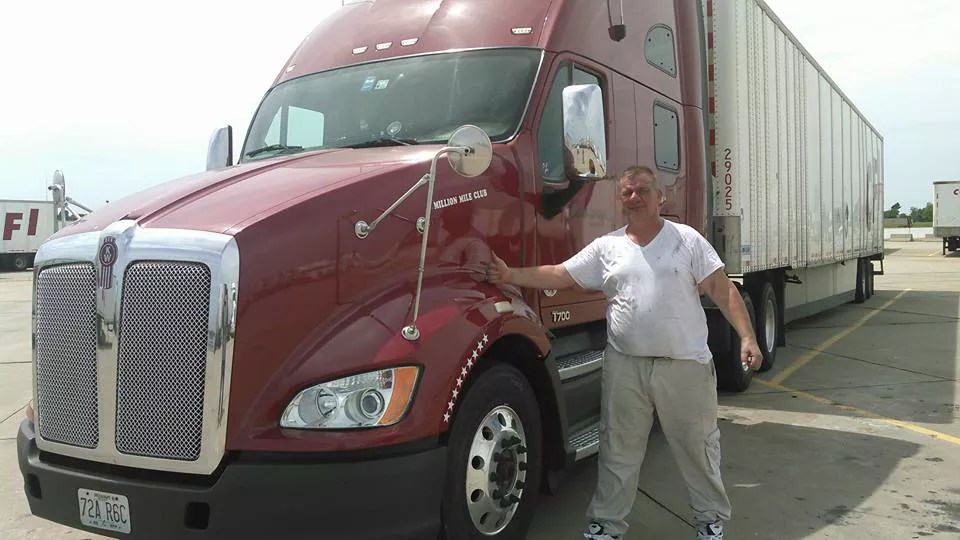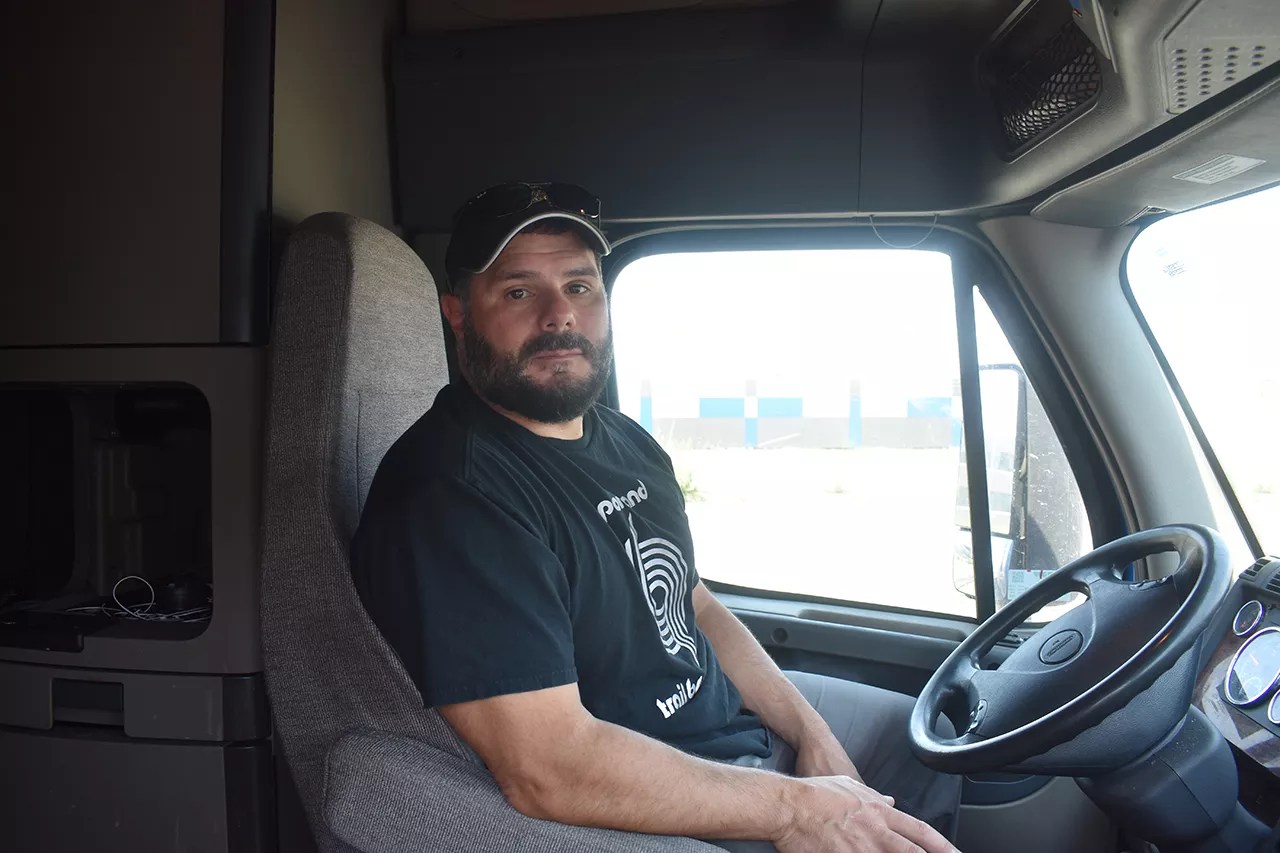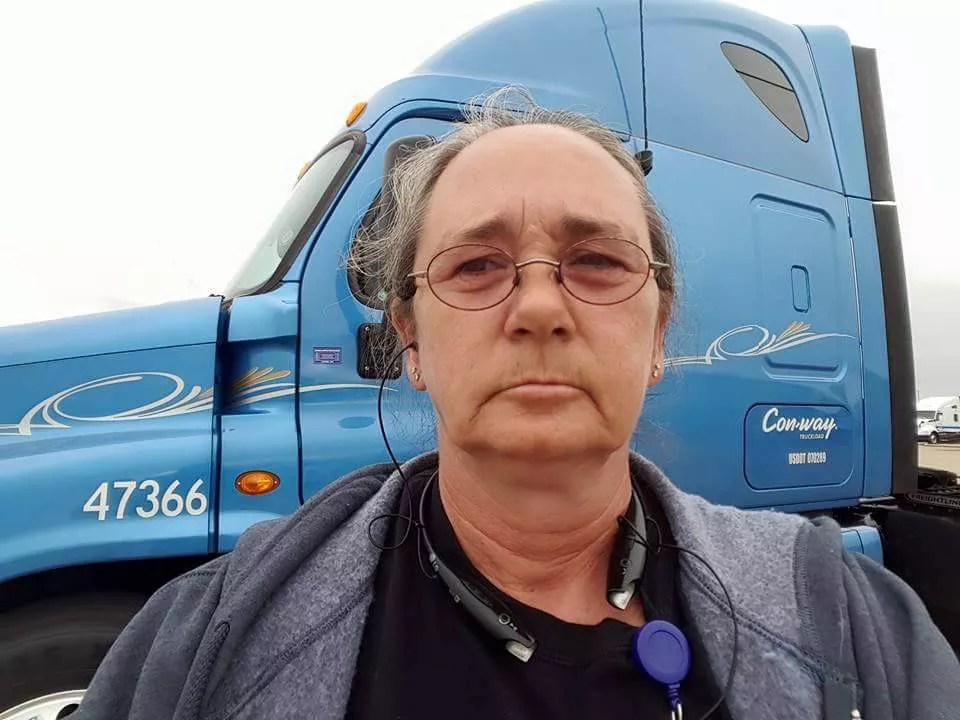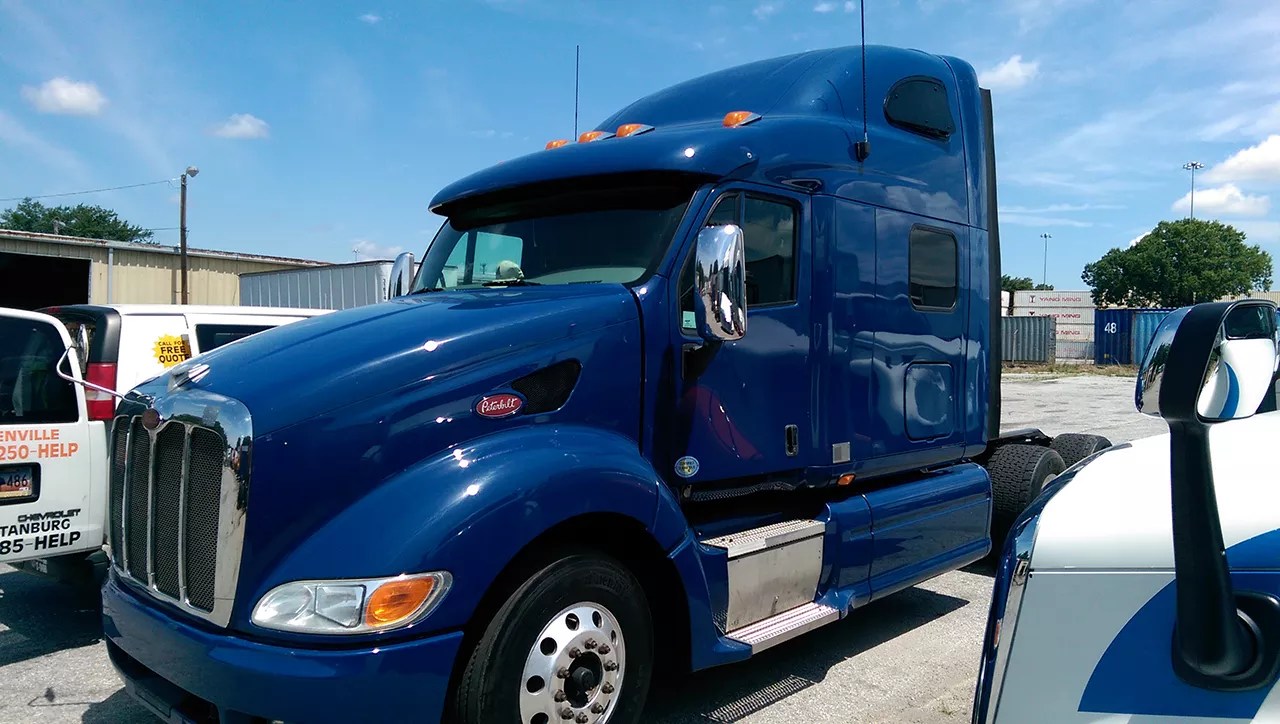
Getty Images/Christian Adams

Audio By Carbonatix
Like many long-haul truckers, Frank Merrill dreamed of being his own boss. Some day, he told himself, he would buy his own big rig and become an owner-operator, king of the road, choosing what loads and routes he would take and carving out more time for a life outside the truck.
Merrill considered himself well-informed about the trucking industry and its pitfalls. His grandfather, his father, his uncle and his brother all drove trucks for a living. After he got out of the Army, a tour of duty that stretched from Desert Storm to Afghanistan, Merrill settled in El Paso and began driving a company truck for a Missouri-based carrier. The company changed names several times – Con-way, XPO Logistics, CFI – as the result of takeovers and mergers, but Merrill enjoyed the work. CFI took good care of its trucks and its drivers.
But after eleven years on the job, Merrill saw his income shrinking. Even though he was an employee, he was paid by the mile – and the miles he was offered were dropping. Drivers’ relationships with their company are only as good as their rapport with the dispatchers who assign the loads, and Merrill suspected he was being denied longer, more profitable runs because of disagreements with a dispatcher.
“A company won’t fire you, but they’ll run you out of the business,” Merrill says. “I wanted to stay with that company, but as an owner-operator.”
The problem was Merrill’s credit score – which was “dirt low,” he says. He couldn’t obtain financing for the purchase of a new big rig, which can cost from $80,000 to more than $150,000. (That’s just for the semi-truck; the trailer can run another $50,000 or more.) He decided to look into a lease-purchase program CFI was promoting to its employees as a way of becoming an owner-operator.
The leasing company, Pathway, was based in Littleton. It had an arrangement with Merrill’s company that allowed Pathway to park a few of its trucks on CFI’s property in order to draw attention to the leasing deal. When Merrill went to CFI headquarters to check out the trucks and the program, he thought the people answering his questions were Pathway representatives; they turned out to be CFI employees.
Merrill was shown a truck that had more than 500,000 miles on it. He wasn’t allowed to test-drive it before signing a lease agreement. He didn’t entirely understand what was in the agreement, but he was reassured by a service contract that seemed to cover major repairs over the first year or first 100,000 miles of the lease. After some vacillation – time is money to a trucker, and Merrill wasn’t earning anything hanging around a storage yard in Joplin, Missouri – he signed the deal.
“The main reason I signed it was desperation,” he says now. “I wanted to get my miles up, I wanted to bring home some money and start taking care of my family. It was a pure desperation move on my part.”
On his first run, a suspension airbag blew on the truck, the first of several mechanical issues that sidelined Merrill for days or weeks at a time and led to frequent phone calls with Matthew Harris, the president of Pathway Leasing. Merrill says he checked out the truck’s history on Rigdig, an online service similar to Carfax, and learned that it had formerly belonged to a company that had a reputation for not taking good care of its fleet. He also discovered that the warranty he thought he was getting hardly covered anything he thought it did, and that he was expected to shell out thousands of dollars in maintenance and major repairs, to be performed only with Pathway’s approval and at shops authorized by Pathway. “They told you who could fix it and how much you were going to spend, just like a company driver,” Merrill says.
“It was a pure desperation move on my part.”
In many ways, the experience was worse than being a company driver. Merrill could refuse to haul loads that he viewed as money-losers, but to refuse a load meant you might wait several days to get another one. And Merrill was expected to work exclusively with CFI; he couldn’t switch to another carrier, paying a better price per mile or offering better loads, without Pathway’s approval. Pathway preferred to work with certain companies, like CFI, that agreed to send the driver’s weekly earnings for miles driven – called a “settlement,” not a paycheck – directly to Pathway, which deducted lease payments and other charges before sending the remainder on to the driver.
The arrangement was specified in the lease, but Merrill hadn’t realized how little would be left after the $3,600-a-month lease payment, fuel costs, repair bills, oil changes, insurance, cash advances for meals and other expenses. Despite regularly working seventy hours a week, “I was lucky to walk out of there with $200 a week,” he says. One week he drove 2,744 miles, loading or unloading in eight cities, and netted zero dollars.
After spending thousands on transmission and engine work, Merrill was deeply in the hole – and another breakdown left him facing $23,000 in repair costs that he didn’t have. CFI canceled its contract with him. In 2016, one year after he signed the lease agreement, Pathway towed the truck from his driveway. Merrill says he spent $82,000 on a truck he never got to own; he ended up filing bankruptcy and is still paying off a bank loan from that ruinous year. His wife passed away in 2019 from respiratory issues; Merrill believes the financial strain of his situation contributed to her health problems. “We went through a lot of emotional distress, wondering what we could do,” he says.
Merrill is now the lead plaintiff in a lawsuit filed in federal district court in Denver, alleging that Pathway and CFI acted as “joint employers” of the lease drivers, mis-classifying them as independent contractors and failing to pay them the federal minimum wage of $7.25 an hour. CFI was dismissed as a defendant in the action, but the case against Pathway went to a bench trial before U.S. Magistrate Judge Kristen Mix in 2018. Thirty-one months later, Mix has yet to issue a verdict.
“When you look at the ripple effect of working years on end without being properly paid, the damage is already done,” says John Crone, the Denver employment attorney representing fourteen truck drivers in the lawsuit. “The houses are lost, the marriages have crumbled.”
The Pathway case is one of several across the country that have been filed by drivers, challenging what they claim are predatory leasing schemes. The cases have exposed dark corners of a chaotic and highly competitive industry, one that often treats truckers not as lords of the highway, but as disposable serfs, bound to their masters by a form of debt peonage. The lease deals also raise public-safety concerns, as testimony has emerged concerning drivers’ long hours behind the wheel. Merrill and others say truckers feel pressured to push federal limits on their working hours as they struggle to make payments on high-mileage big rigs that may not be entirely roadworthy.
“They’re doing exactly the same thing they did before. The only difference is they’re not making any money.”
Matthew Harris started Pathway nearly a decade ago, after working for Lakewood-based ATBS, a company that provides financial services to the trucking industry. He has maintained that his company’s leasing program isn’t predatory and is designed to give truckers a shot at a better life. He declined to comment on the litigation and would not provide data on how many of his clients actually complete their leases. But in a brief written statement, he characterized the success rate of Pathway clients as “far above the industry norm.” During the trial, his attorneys pointed out that several of the plaintiffs in the lawsuit completed their leases and ended up owning their own trucks.
But Crone views the lease terms as highly exploitive.
“It’s really an insidious arrangement,” he says. “They essentially took this vulnerable population and said, ‘You’re going to make all this money and be independent.’ What Pathway was really doing was setting up a guaranteed revenue stream for itself. A lot of these people were company drivers before CFI pushed them over to Pathway and signed them up for a truck lease. They’re doing exactly the same thing they did before. The only difference is that they’re not making any money.”

Frank Merrill’s Pathway truck was towed away a year into the lease.
Courtesy of Frank Merrill
America relies on the trucking industry to move almost 12 billion tons of freight a year. That’s twice as much freight as is shipped by air and ten times what is carried by rail. Truckers are essential to most forms of commerce around the globe and were hailed as “the heroes of the pandemic” during the shutdown last spring, the road warriors responsible for replenishing depleted store shelves and keeping the supply chain from collapse. Yet many long-haul truckers barely earn enough money to pay their operating costs, despite spending weeks or even months at a time on the road, away from their families.
For many years, driving a truck was regarded as a blue-collar worker’s ticket to the middle class. The industry was dominated by large companies and unionized drivers; some of the most successful drivers even earned a second paycheck by buying their trucks and leasing them back to the company. But a push for deregulation of the industry in the 1970s and 1980s brought dramatic changes. Most of the largest carriers went under, the losers in cutthroat bidding wars over freight prices with upstart, non-union companies. Drivers lost benefits and saw their earnings plunge even as their workload increased. Today more than 90 percent of American trucking companies operate fewer than twenty trucks, and the average long-haul trucker makes about $45,000 a year. It’s an industry driven by the cheap price that carriers pay drivers for moving freight – as little as 75 cents or a buck a mile, before fuel costs and other expenses the drivers usually have to cover. Income can vary wildly from week to week, depending on what kind of loads or delays the driver is facing. Not surprisingly, turnover is high, as are company complaints about a shortage of experienced drivers.
“The industry complains that they don’t have drivers and can’t hire young people,” notes Michael Belzer, an economics professor at Wayne State University who’s studied trucking operations for decades. “But the industry does everything it can do to keep from paying people more money. If you really had to pay people for their time, it’s going to be more costly to deliver the freight.”
Belzer, who titled his book on the industry Sweatshops on Wheels, cites research indicating that a substantial hike in truckers’ compensation would not only cut down on turnover, but result in a fourfold reduction in truck crashes. As it stands, though, truckers have few ways to increase their income. Federal rules limit how many hours they can drive and impose mandatory breaks. Many end up spending huge chunks of their work week on uncompensated but necessary tasks, such as required safety inspections before and after trips, loading and unloading, and waiting around a shop while their rig is being repaired or serviced.
“More than 50 percent of all truck drivers don’t get paid for their non-driving time,” Belzer says. “Imagine an assembly line that stops because there’s a defect in some part, and the factory worker has to just sit there, not paid, until it gets fixed. That’s essentially what happens to a truck driver.”
“The industry does everything it can do to keep from paying people more money.”
For drivers looking for a way out of the maze, becoming an owner-operator seems like a smart move, one that can give them more control over how much they drive, at what price, and where. But unless they can afford a new truck, the quest can take them to a leasing company like Pathway, or an in-house lease-purchase program at their own company, offering them older trucks that will take years to pay off.
“It sounds good, but there are so many loopholes,” says Norita Taylor, spokesperson for the Owner-Operator Independent Drivers Association, which represents more than 150,000 truckers in the United States and Canada. “There’s always something that needs to be fixed. If you’re getting paid by the mile, you’re not going to be able to keep up.”
Taylor concedes that in some cases, lease arrangements can work well for the driver. But she believes it’s an aspect of the industry that requires much greater government scrutiny than it’s received. “States need to step in and make these [predatory] programs illegal,” she says.
Last fall, in comments on proposed U.S. Department of Labor rules, the OOIDA leadership denounced leasing as a blight on the industry. “Lease-purchase schemes can only be described as indentured servitude,” the group declared. “Drivers are paid pennies on the dollar, will likely never own the truck, and have zero independence.”

Sociologist Steve Viscelli calls leasing an industry threat.
Courtesy of Steve Viscelli
During opening statements in the Pathway trial in 2018, one of the attorneys representing the company stated that entering a lease agreement with Pathway was a purely voluntary decision on the part of the drivers. They didn’t have to sign if they didn’t like the terms, and it was up to them how much they drove, what companies they’d haul freight for, or how much time they decided to take off.
“No one forced them to become an owner-operator,” insisted Mark Wiletsky, a Holland & Hart attorney representing Pathway. “They wanted an opportunity to be in business for themselves. And some did very well, grossing as much as $200,000 in a year.”
Plaintiff Ronald Lacy was one of the drivers who, by Wiletsky’s criteria, did “very well” in the Pathway lease program. But Lacy looks at the experience differently. He didn’t have much choice about getting into the deal in the first place, he says, and while his gross revenues might look impressive on paper, the reality was much grimmer.
“I would never do this shit again, man,” Lacy says. “I had to work like a slave.”
Lacy worked as a company driver for CFI for four years. The company fleet manager encouraged him to look into leasing a truck from Pathway. He went to Dallas to look at four trucks that Pathway was offering for lease. Belatedly, he says, he was told by CFI management that if he pursued this opportunity to become an owner-operator, he couldn’t go back to being a company driver.
“They gave me the [leasing] contract at four o’clock on a Friday in Dallas,” he recalls. “And they told me if I didn’t sign it by five, I wouldn’t have a job.”
Lacy signed. He drove the truck to Joplin so that it could be inspected and outfitted with CFI logos and communication equipment. Lacy says the inspection revealed eight drive tires and six airbags that were “dry-rotted and ready to pop.” He paid out of his own pocket for new tires and airbags and a stream of subsequent repairs. Add the monthly lease payments, as well as the $1,000 a month Pathway was taking out of his pay to put into an escrow account for maintenance expenses, and Lacy was scrambling to keep up from day one.
“A lease-purchase is designed for the driver to not ever pay it off,” Lacy says. “But if I lose the truck, I leave with nothing.”
Determined not to come away from the deal with nothing, he started driving as much as he could stand and the federal regs would allow, putting in 2,500 to 3,300 miles a week and accelerating his lease payments. A typical week might take him from Oklahoma City to Dodge City to Laredo to Jacksonville, then home to Alabama. But as the pace increased, he had to forgo the trips home, even on holidays. One year he made it home three times. He asked Harris at Pathway for permission to work for another, better-paying carrier, but was refused, he says, because Pathway didn’t have an arrangement to be paid directly by that carrier.
“A lease-purchase is designed for the driver to not ever pay it off. But if I lose the truck, I leave with nothing.”
Testifying at the trial, Lacy admitted that he grossed around $200,000 one year and $170,000 the next. But he insisted that most of the money went to fuel, Pathway payments and repairs. Some weeks he netted as little as a couple hundred dollars. He couldn’t afford a motel room, slept in the truck most nights, and sacrificed any kind of family life for life on the road. “I paid off the lease six or seven months early because I was trying to get the Man out of my pocket,” he says now.
Lacy says he paid more than $100,000 for the truck, which he still drives today. The vehicle had 600,000 miles on it by the time he paid it off, and repair issues have continued to dog him. “Everything on it is brand-new except for the motor,” he reports.
He’s his own boss now, driving for another carrier as an owner-operator. He can check the computerized load board in his truck and see what loads are available in which states and what they pay, then pick the best options, rather than being forced to take on a heavy load that’s going to put a lot more wear and tear on his aging ride. But what he feels about Pathway and its lease-to-own program can’t be described as gratitude.
“Nobody’s looking out for us at all,” he says. “I don’t recommend that anyone should lease a truck. Save up and go to a dealership.”

Becky Austin paid off her Pathway truck – at great cost.
Courtesy of Becky Austin
In the course of researching his 2016 book, The Big Rig: Trucking and the Decline of the American Dream, Steve Viscelli spent six months training and working as a long-haul trucker. At truck stops and loading depots across the country, he met a lot of people working brutal hours for little pay. Some managed to claw their way to a more stable life, but a great many more were part of the “churn,” drifting into the industry and quickly abandoning it.
Some had signed up for “free” training from companies – truck-driving lessons and certification assistance that were only free if you stayed with the company for a year or more. Others had entered lease programs that plunged them into an abyss of debt.
“I have seen turnover of hundreds of percent annually in these leasing programs,” says Viscelli, a sociologist at the University of Pennsylvania. “The drivers in them make no sense as a risk for a truck lease, or dealers would be doing that. The reality, from an economic perspective, is that you have the carrier and the leasing company structuring the deal hand in glove.”
Even if the carrier isn’t profiting directly from the leasing arrangement, Viscelli explains, it benefits in several ways by converting company employees into supposedly independent contractors. The shift saves money on health and retirement benefits, workers’ comp and unemployment insurance, cutting as much as 30 percent in labor costs. The capital and operating costs of the truck – depreciation, maintenance, insurance and so on – are now the driver’s headache. And the downside for the carrier – that the driver can now choose who to work for – turns out not to be a problem at all. Viscelli contends that the independent contractors are more compliant than company employees because they’re more desperate.

Tony Glover won driver-of-the-month awards from trucking company CFI.
Courtesy of Tony Glover
“Your freedom to choose loads actually goes down when you’re an independent operator,” he says. “If you refuse a load as an employee, they’re still paying the overhead on the truck. The company is going to move that company truck. But if you’re an owner-operator and they sit you for three days because you don’t want the load, you’re thinking you have to call the wife and tell her that the mortgage isn’t going to get paid that month.”
The reality is that most lease drivers are dependent on a single carrier for their revenue, and they need to work many more hours than they ever worked as a company driver to earn take-home pay comparable to what they had before. In a U.S. Supreme Court brief filed in a lawsuit against one company’s lease program, Viscelli declares that such programs pose “a serious threat to the nation’s trucking industry, which in turn jeopardizes the economy.”
Becky Austin can’t speak for the industry or the national economy, but leasing a truck did more than jeopardize her personal finances; it demolished them. Austin drove for CFI for five years, saving up money to buy her own truck. She was within moments of putting down $80,000 cash on a new Kenworth when she changed her mind, figuring a lease deal might be a less daunting alternative. She had seen the ads from CFI management about the Pathway program and decided to give it a try. “They told me that if I had to walk away from it, I could,” she recalls.
Like other drivers, she was denied a test drive of the truck she leased because she didn’t yet have insurance on the vehicle. When she was finally allowed to drive it, it overheated. Repeated trips to the shop kept her off the road; she logged only 1,700 miles in six weeks. The truck couldn’t make it up the approach to the Eisenhower Tunnel, so she had to take it to Grand Junction for repair, then to another shop in Salt Lake City. She let Harris at Pathway know that she was leaving it there.
“He flat told me that he didn’t like what I did with that truck, and that I would go back after it,” Austin recalls. “I told him that just because I was a woman didn’t mean I was stupid.”
Harris offered her a replacement truck that had 600,000 miles on it, Austin says. She refused. She accepted a third lease-purchase truck only after repairs to fix a shimmy and bad tires. But the repair costs continued to mount, and most of those costs came right out of Austin’s pocket. Although she was often driving 3,000 miles a week or more, her take-home pay on some runs averaged around four dollars an hour. CFI paid cash bonuses to drivers like Austin who logged more than 11,000 miles a month, but there was a penalty built into the Pathway lease for driving the truck more than 30,000 miles in three months; in effect, the bonuses she earned went to Pathway.
Back when she was about to buy the brand-new Kenworth, Austin had close to $100,000 in savings. Her nest egg is now down to about $3,000, she says. She took out a loan last summer to pay off the balance of the lease and now owns a truck with 800,000 miles on it that she paid well over $100,000 for, including repairs.
But at least Austin ended up with a truck. Pathway plaintiff Tony Glover describes his experience as a “horror story,” with all the familiar plot points: payments that were higher than he expected, a service contract that turned out to be less than he expected, lots of breakdowns and downtime and bills he couldn’t pay, no switching of carriers without Pathway’s approval, no escape.
“It was like I was working for Pathway instead of making money for myself,” he says.
Glover won driver-of-the-month awards from CFI while being dinged by Pathway for excessive mileage. He grossed nearly $200,000 a year but took home around $30,000. He took out advances on his pay that were supposed to be for fuel and sent them home to pay bills. As he fell deeper into debt, he was forced to take his nineteen-year-old daughter out of college.
One day near Stratford, Pennsylvania, he was idling at a traffic stop. When it was his turn to go, the truck wouldn’t. He stared at the “check engine” light on his dash and decided there was no point in flushing more money down the drain. He called a wrecker to tow the truck. Then he called his wife and told her, “I can’t do this anymore.”
Glover says he’d paid Pathway around $85,000 at that point. But it was still Pathway’s truck. It would be until he paid every cent owed under the lease, regardless of what it was going to cost him in repairs to get there. For what he’d paid, “I could have got a truck straight up for myself,” he notes.
Instead, he walked away.

After ,000 in payments, Tony Glover walked away from his leased truck.
Courtesy of Tony Glover
In 2019, the C.R. England trucking company reached a court settlement over its lease-to-own program with more than 17,000 drivers, agreeing to pay $37.8 million in damages. Many of the plaintiffs had enrolled in the company’s truck-driving school, only to be told that company jobs were scarce and promised more work if they leased a truck. The settlement came only weeks after another mega-carrier, Knight-Swift, agreed to a $100 million settlement in a suit brought by 20,000 owner-operators who claimed to have been misclassified and paid less than the minimum wage.
Last summer two other major trucking companies settled long-running class-action lawsuits over minimum-wage issues. New Prime agreed to pay $28 million to thousands of owner-operators in back compensation and damages in a case that also involved claims of predatory leasing. Pam Transport settled with more than 16,000 drivers over alleged violations of the Fair Labor Standards Act, including a claim that drivers were supposed to be on duty “continually for days and weeks on end.”
Drivers are still waiting on a verdict in the Pathway case, but several rulings made by Magistrate Judge Mix represent setbacks for their cause. Mix dismissed CFI as a defendant in the lawsuit on the basis of an arbitration clause in the drivers’ agreement with the carrier. She also refused to grant a jury trial because of a jury waiver clause in the leasing agreement drivers signed with Pathway. Having certified the case as a class action, she granted a motion by Pathway for decertification after the trial concluded, effectively removing a potential class of more than a hundred plaintiffs; Becky Austin was one of dozens of plaintiffs who’d “opted in” to the case and saw their claims dismissed.
“All these plaintiffs who opted in were dismissed after they just went through this trial, which I thought was extraordinary,” says attorney Crone.
At trial, Mix was skeptical of the truckers’ claims that they were somehow forced into the lease deals. “Unless there is some showing of actual coercion in execution of a document, I don’t know what law would allow me to find that the plaintiffs are excused from complying with and understanding the terms of their written leases,” she observed.
“It’s cheaper to replace people every three months than pay people more to retain them.”
At the same time, she said that she was troubled by the evidence presented of “a very close relationship” between Pathway and CFI in administering the leases. Emails and other documents showed close coordination between the companies on matters ranging from what trucks to offer for lease to how to structure the deals and whether certain drivers were good risks for promissory notes.
Four years ago, the newly installed Trump administration set about doing what it could to keep government out of the private sector’s business. Although it had pledged to bring relief to working stiffs, its biggest gift to the trucking industry was a new Department of Labor rule that made it harder to challenge the kind of “joint employer” relationship that the drivers claim Pathway and CFI had, along with other changes that effectively extended the number of hours that truckers can work in a day and increased their taxes.
The government has usually sided with the big bosses in the truck business, rather than the people who want to be their own boss, for decades. Steve Viscelli points out that federal funds help to subsidize the training programs that bring thousands of wannabe truckers into the business, while little is done to address the turnover and the burnout that veteran drivers experience after too many years of too many miles and too little pay.
“It’s cheaper to replace people every three months than pay people more to retain them,” Viscelli says. “And the job is difficult. If you have friends, family, a home, it’s not going to be a great job for you.”